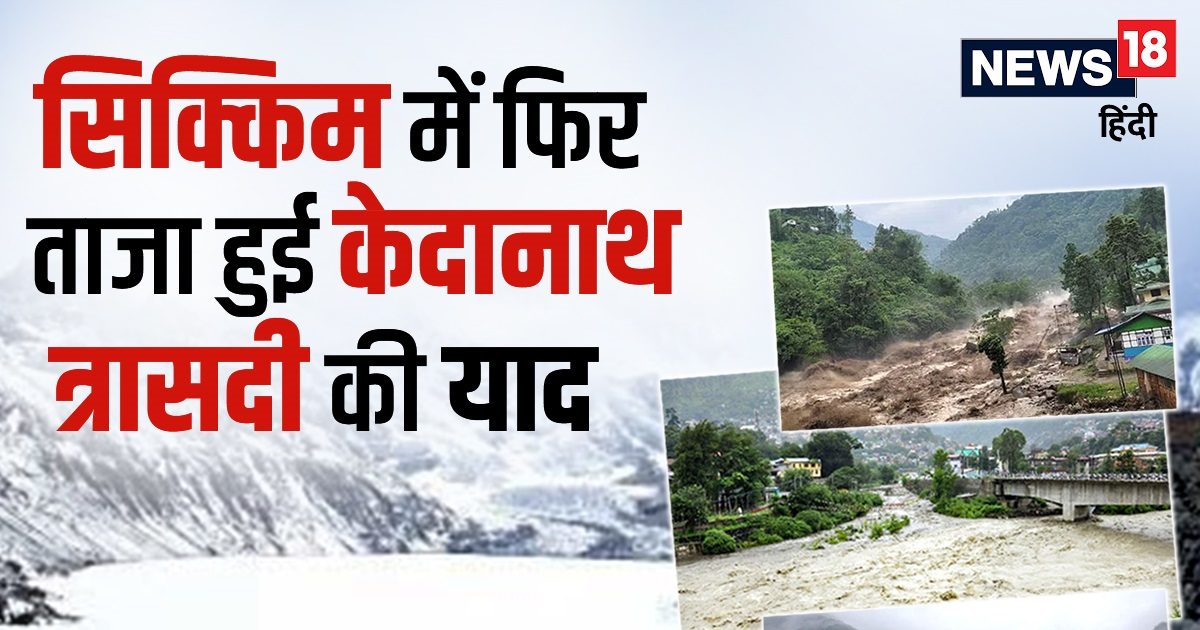Gangtok: A disaster caused massive damage last night in Sikkim, a state located in the north-east of India. The surge in Teesta river due to cloudburst engulfed the Indian Army camp, in which 23 soldiers were washed away. All of them are missing and their search is on. Many army establishments also suffered major damage, 41 vehicles were buried under the debris brought with the water. This disaster reminded us of the Kedarnath tragedy of 2013. The same thing happened in Sikkim, which happened in Kedarnath.
Mangan district lies in the northern part of Sikkim. Chungthang is its high altitude area, in whose lap is South Lhonak Lake. Which is a natural freshwater lake. The height of Lhonak Lake is about 17000 feet above sea level. This lake is about 260 feet deep, 2 kilometers long and half a kilometer wide. The cloud burst over this lake on Tuesday night. Suddenly a large amount of water fell into the catchment area of this lake. Due to this the walls of the lake broke. Since this lake is located between high hills, the water started flowing rapidly towards the lower areas.
The cause of Kedarnath tragedy happened in Sikkim.
Teesta river flows below. The water coming out of the lake entered the river and Teesta was in spate. Since a lot of water was coming down rapidly from a height of 17000 feet, stones and debris also came flowing in it. The water level of Teesta river, which is light green in colour, suddenly increased by 20 feet. It started flowing in yellow and beige colour. There was a sudden water explosion in Lachen valley. Due to the sudden rise in the water level of Teesta, several military installations in the valley were washed away, including 23 soldiers. Additionally, dozens of homes and public infrastructure were also damaged.
The possibility of bursting of Lhonak Lake was expressed in advance.
Lhonak Lake is one of the 14 glacial lakes of Sikkim, whose bursting was feared in advance. Scientists had described it as extremely sensitive to Glacial Lake Outburst Flood (GLOF). The Central Government had presented a report in Parliament on March 29 this year, in which it was told that due to climate change, the glaciers of the Himalayas are melting rapidly. The water level of the rivers originating from the Himalayas can cause natural disaster at any time. The government has admitted that due to melting of glaciers, the risk of natural disasters like Glacial Lake Outburst Flood (GLOF), glacier avalanche, avalanche etc. has increased.
Himalayan glaciers are melting 10 times faster
In the report presented in Parliament, it was told that the earth’s temperature is increasing due to climate change. In the Himalayas, the number of cold days and nights is decreasing and the number of hot days and nights is increasing. In the last 3 decades, cold days and nights have decreased by 2 to 6 percent. At present, scientists are keeping an eye on two dozen glaciers. The main ones are Gangotri, Chorabari, Dunagiri, Dokriani and Pindari. Scientists from the University of Leeds studied 14,798 glaciers in the Himalayas. He told that in the last decades, the glaciers of the Himalayas have been melting 10 times faster than before. The water released due to their melting has increased the sea level by 0.92 to 1.38 mm.
.
Tags: Floods, Heavy rain and cloudburst, Sikkim, Sikkim News
FIRST PUBLISHED : October 4, 2023, 1:54 PM IST


